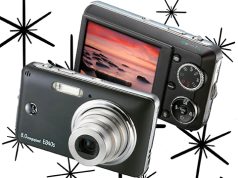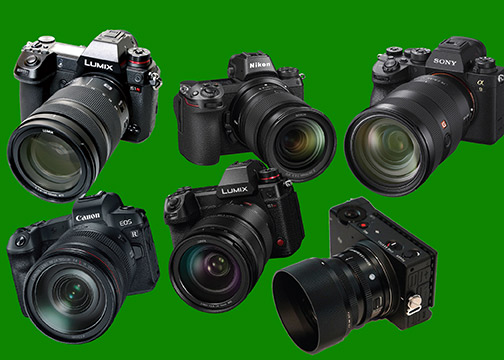
Mirrorless interchangeable-lens cameras (ILCs) are now the dominant force in the imaging marketplace. They far surpass DSLRs in terms of new product introductions and unit sales. And while, to paraphrase Mark Twain, the demise of the traditional DSLR is greatly exaggerated, consumers ranging from emerging enthusiasts to seasoned pros are gravitating toward mirrorless models (all formats). And lately, toward full-frame mirrorless cameras.
The reasons aren’t hard to fathom: mirrorless cameras deliver a DSLR-like shooting experience in a more compact form factor. Moreover, they do so along with technical advantages like full-time autofocus and autoexposure (AF/AE) during the exposure; enhanced responsiveness; a live view electronic viewfinder (EVF) that displays exposure and color corrections in real time; inherently less noise and vibration; as well as superior imaging performance when shooting high-speed bursts and 4K video.
Yes, some high-end pro DSLRs can deliver comparable performance. However, they are inevitably larger, heavier and more expensive.
As a comprehensive, multifaceted class, mirrorless cameras are at the point of the spear when it comes to innovation. Indeed, that’s true across the format spectrum, ranging from Micro Four Thirds to medium-format systems. However, in their stunning variety of form factors, conceptual uniqueness, technical ingenuity and brilliant functionality, full-frame mirrorless cameras are at the sweet spot. They comprise the most rapidly expanding category within the mirrorless domain. Additionally, it’s fair to say that more serious shooters and pros than ever now aspire to own a full-frame mirrorless camera.
Why Full-Frame Mirrorless?
Full-frame mirrorless cameras have piqued the interest of savvy consumers and leading manufacturers alike; that’s primarily because they have the potential of delivering superior image quality, especially at high ISOs. What’s more, they feature sophisticated video applications, such as recording in DCI and 4K UHD video at up to 60p. They also use longer lenses than Micro Four Thirds and APS-C-format models. Thus, they provide shallower depth of field as well as enhanced depth-of-field control at any given aperture and coverage angle.
Sony sparked the full-frame mirrorless revolution with its enormously successful Alpha 7 series. The new flagship Alpha 7R IV with its 61MP Exmor CMOS sensor and the sleek, compact 24.2MP Sony 9 II are striking examples of how they’ve evolved the category.
In addition, the recently introduced 47.3MP Panasonic Lumix DC-S1R is another outstanding full-frame model. As is the 24.2MP Panasonic Lumix DC-S1H.
It’s also significant that Nikon and Canon both entered the mirrorless category with serious high-res full-frame top-of-the-line models: the 45.7MP Nikon Z 7 and the 30.3MP Canon EOS R. Moreover, Leica recently upped the performance ante with the formidable new Leica SL2; it incorporates a new ultrahigh-res sensor coupled to a state-of-the-art Maestro III image processor. The wildly enthusiastic reception for the incredibly slim ultracompact full-frame Sigma fp is also another harbinger of things to come.
We expect to see other manufacturers embrace the ultracompact full-frame mirrorless system concept. In short, 2020 will definitely be a banner year for full-frame mirrorless fans and for the knowledgeable dealers who serve them.
To celebrate, we’ve selected six sensational FFMs to represent the category and to give you a clearer picture of the latest advances in this crucial category. Have a Healthy, Happy and Prosperous 2020.
Six Sensational Full-Frame Mirrorless Cameras
Panasonic Lumix DC-S1R
The first full-frame mirrorless ILC from Panasonic is a solid, heavy-duty, weatherproof, L-mount model. The high-res, full-featured camera is targeted squarely at the expanding pro market. Its full-frame 47.3MP MOS sensor integrates with a high-performance Venus Engine image processor. Subsequently, the ILC supports 4K UHD video recording at up to 60 frames per sec as well as an impressive maximum 9-fps, full-res burst rate with AF-S or 6 fps with AF-C. The camera also provides sensitivity settings from ISO 100 to ISO 25,600.

Moreover, it employs a 225-zone contrast-detection DFD (depth-from-defocus) AF system. The system can adjust the focus position in as little as 0.08 sec with sensor-to-lens communication at rates up to 480 fps. Furthermore, Panasonic’s Dual IS 2 image stabilization combines 5.5-stop-rated, 5-axis sensor shift with in-lens 2-axis IS when using compatible Lumix lenses.
The S1R’s cutting-edge live viewfinder is an ultrahigh-res 5.76M-dot, 0.78x-magnification OLED LVF. It features a selectable, smooth 60-fps or 120-fps refresh rate; a 0.005-sec lag time; and a 10,000:1 contrast ratio. The LVF is complemented by a large, 3.2-inch, 2.1M-dot triaxial, tilt, touch-screen LCD. Other features include: 6K photo functions; 187MP high-res mode; HLG mode for enhanced dynamic range and shadow detail; built-in Wi-Fi and Bluetooth connectivity; XQD and SD card slots; a USB Type-C port; and a splash/freeze-resistant, magnesium alloy body. $3,699.99.*
Nikon Z 7
Nikon’s exceptional high-resolution, pro-aimed mirrorless full-framer sure looks rugged and purposeful—and it is. Based on a 45.7MP FX-format BSI (backside-illuminated) CMOS sensor coupled to an advanced Expeed 6 image-processing engine, this high-tech ILC delivers impressive performance parameters. The Z 7 records 4K UHD video at 30 fps with N-Log for capturing an enhanced dynamic range. It also achieves 10-bit HDMI output and has an extended sensitivity range of ISO 64–25,600. What’s more it has an impressive full-res burst rate of up to 9 fps.

The Z 7 is designed around Nikon’s new wide-diameter Z mount with a shorter 16mm flange distance. This allows the use of more compact wider-aperture Nikkor Z lenses. However, legacy Nikkor F-mount lenses also can be used with the mount adapter FTZ. When doing so, they gain the advantages of the Z 7’s in-body vibration reduction, silent shooting and PDAF focusing system. The optional adapter also supports E-, G- and D-type Nikkor lenses.
In addition, a 493-point phase-detection AF system works with built-in 5-axis VR image stabilization to combat the effects of handheld shake. Other features include: a 0.8x, 3.6M-dot EVF; a 3.2-inch, 2.10M-dot, tilting, touch-sensitive LCD monitor; and a top panel dot-matrix OLED display that enables the monitoring of settings when the camera isn’t at eye level. What’s more, an XQD card slot and built-in Wi-Fi/Bluetooth connectivity are provided. The Nikon Z 7 has a robust, weather-sealed magnesium alloy body. $3,399.95.
Sony Alpha 9 II
The second generation flagship of Sony’s full-frame Alpha series provides even more speed than its impressive predecessor. It also sports a cleaner, handier, more attractive form factor. The a9 II delivers impressive multimedia capabilities for ultrafast continuous shooting and pro caliber video capture.
It employs a 24.2MP full-frame Exmor RS stacked CMOS sensor and front end LSI coupled to an advanced Bionz X image processor. The ILC shoots a continuous full-res burst at up to 20 fps using its electronic shutter (AF/AE tracking) and up to 10 fps via its mechanical shutter. It also performs up to 60 AF/AE functions per sec. Multimedia capabilities include 4K UHD (6K equivalent) video recording at 30 fps and 8K still grabs from video. It records with full-pixel readout sans pixel binning and condenses 2.4x the amount of data needed for 4K.
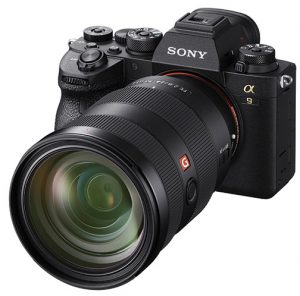
The a9 II also provides sensitivity settings extendable from ISO 50 to ISO 204,800. In addition, an advanced 693-point phase-detection AF system with 25 contrast-detection points is sensitive down to -3 EV. Further, 5-axis SteadyShot Inside sensor-shift image stabilization provides a 5.5-stop advantage when shooting stills or video.
Other features include: a blackout-free 3.69M-dot OLED EVF; a 3-inch, 1.44M-dot, tilting touch-screen LCD; real-time eye AF for humans and animals; anti-flicker shooting for artificial lighting; and a silent electronic shutter. Its robust, weather-sealed body has a magnesium alloy chassis and incorporates Wi-Fi and Bluetooth connectivity; dual UHS-II SD slots; integrated LAN and PC terminals; as well as FTP transfer. $4,499.99.
Sigma fp
Sigma’s sensational L-mount ultracompact ILC is literally a game changer that resets the boundaries of the full-frame mirrorless class. The groundbreaking fp provides pro-caliber still and video functionality in an amazingly slim-line, weather-resistant die-cast aluminum body. Measuring just 4.43×2.75×1.78 inches, it weighs in at under 15 ounces (body only, including Li-ion battery and SDXC card).
At its core is a 24.6MP BSI full-frame Bayer CMOS sensor minus a low-pass filter. It enables 14-bit color depth as well as full-res bursts at up to 18 fps. It also incorporates a 49-point contrast-detection AF system that provides face detection, eye detection and focus peaking readouts. What’s more, its base sensitivity range of ISO 100–25,600 expands from ISO 6 to ISO 102,400.
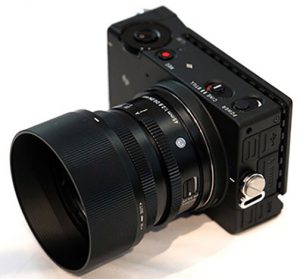
Video capabilities include 4K UHD recording at up to 30p as well as Full HD recording at 120p. In addition, it supports 12-bit CinemaDNG external recording for raw video data. The fp also provides Sigma’s teal and orange mode that mimics high-end Hollywood color-grading techniques. And a “director’s viewfinder” function provides simulated professional effects like those captured by Arri and Sony cameras. Other features include: a 3.15-inch, 2.10M-dot, touch LCD; a UHS-II SDXC slot; a USB 3.1 Gen 1 Type-C port; and an HDMI port. In addition, the fp offers a handy platform for custom configuration by adding Sigma and third-party accessories via dedicated mounts. Photographers can mount Sigma SA and Sigma EF lenses via the optional MC-21 mount converter. $1,899.
Canon EOS R
Canon’s landmark high-performance mirrorless marvel is aimed at a broad spectrum of serious shooters, including pros. Crisply styled, it features a full-frame 30.3MP CMOS sensor coupled to a high-tech Digic 8 image processor. Consequently, the EOS R boasts such advanced capabilities as 4K UHD video capture at 30 fps with Canon Log Gamma for improved dynamic range; 10-bit HDMI output; expanded sensitivity settings from ISO 50 to 102,400; and a full-res burst rate of 8 fps.
It also sports the 54mm-wide Canon RF mount that accepts an advanced new line of more compact, wider-aperture lenses. In addition, legacy Canon EF- and EF-S-mount lenses can be used with an optional EF-EOS R mount adapter.
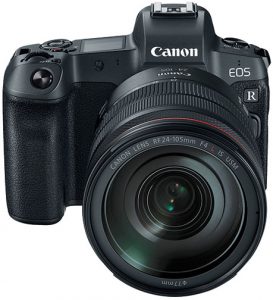
Also provided is Dual Pixel CMOS AF technology with 5,655 selectable AF points and sensitivity down to -6 EV for pro-level low-light performance. Moreover, Canon’s Dual Pixel Raw technology permits slight focus point shifts and other adjustments after capture. Also, a 3.69M-dot OLED EVF complements a 3.15-inch, 2.10M-dot swivel touch-screen monitor. Other features include: movie digital IS to minimize the effects of shake; a customizable multifunction bar for personalized control of settings; Wi-Fi and Bluetooth connectivity; and an SD UHS-II card slot. The EOS R has a dust- and weather-sealed magnesium alloy body. $2,299.
Panasonic Lumix DC-S1H
For serious video shooters, Panasonic’s S1H mirrorless full-frame ILC closely resembles its robust stablemate, the versatile Lumix DC-S1R. However, it has a lower-res 24.2MP full-frame MOS sensor that enables it to record 6K 24p video as well as DCI 4K 60p video with 4:2:2 10-bit sampling.
It also captures a very broad 14-stop dynamic range in stills and video. Additionally, it provides sensitivity settings from ISO 100 to ISO 51,200. What’s more, Dual native ISO sensitivity technology gives cinematographers artistic choices with the ability to prioritize either low noise or low sensitivity. Dual native ISOs are 640 and 4,000. And users can switch manually between low (ISO 640–5,000) and high (ISO 4,000–51,200).

It also provides a pair of gamma settings, V-Log and Hybrid Log Gamma (HLG), for optimizing the dynamic range in postproduction; as well as picture styles, Cinelike V and Cinelike D; anamorphic recording; and in-camera LUT to facilitate monitoring.
Like the DC-S1R, it features an ultrahigh-res 5.76M-dot, 0.78x OLED LVF; in this case, it’s complemented by a large, tilting 3.2-inch, 2.33M-dot touch LCD as well as a top 1.8-inch backlit status LCD for reviewing settings when the camera is off. An internal heat-dissipating fan with an auto setting prevents overheating in high throughput applications, enabling virtually unlimited video recording times. Other features include: a weather-sealed magnesium alloy body; hybrid AF; 14-bit RAW shooting; a double SD slot; and Bluetooth 4.2 and Wi-Fi 5 GHz connectivity. $3,999.99.
*All MSRPs are body only.


